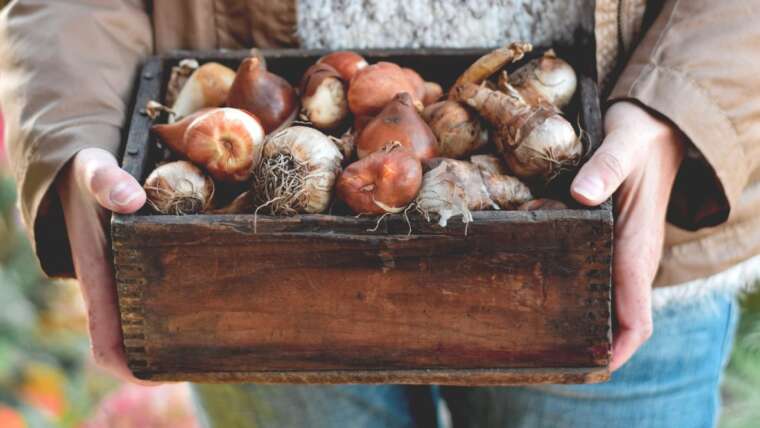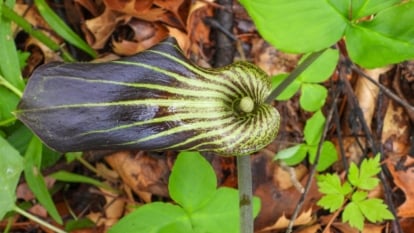Fiddle-leaf figs continue to reign as one of the most popular houseplants on the market. They have a reputation for being fussy, but that hasn’t stopped gardeners worldwide from collecting these towering trees to grow indoors.
If you have a fiddle leaf and want to expand your ficus collection or gift a new plant to family and friends, propagation is the answer. Thanks to the woody stems, the process is a little more complex than some other houseplants, but I certainly wouldn’t consider it difficult – even for beginners.
I like to take cuttings when pruning to propagate every year in spring. Even if you weren’t considering purchasing a new tree, who can argue with an ever-growing collection of lush fiddle-leaf figs?
The Best Time To Propagate
 The best time to propagate a fiddle leaf fig is in spring.
The best time to propagate a fiddle leaf fig is in spring.
For the quickest root growth and the highest chance of success, it’s best to propagate your fiddle leaf fig in spring. Like other houseplants, the slight increase in temperatures in spring triggers new growth in the plant, making it prime time for propagation.
The quickest root growth will occur in the new branches that are still green and malleable. You may want to wait until mid to late spring when these are long enough to trim, but you can still propagate in summer. Propagating during active growth also helps the main plant recover quicker, boosting new growth after pruning.
Technically, you can propagate your fiddle leaf fig at any time of the year. However, unless you can control conditions meticulously, root growth will be much slower over the cooler months. This decreases your chances of success while increasing the likelihood of rot. The branches will also be woody by this time, rooting slower than new, green branches.
What You’ll Need
 Using sharp pruning shears on the thick branches, propagate fiddle leaf figs from stem cuttings.
Using sharp pruning shears on the thick branches, propagate fiddle leaf figs from stem cuttings.
The best way to propagate fiddle leaf figs is from stem cuttings. You may have seen images of individual leaves growing roots online, but we’ll discuss why that’s not the best method later on.
To propagate from cuttings, start by gathering sharp pruning shears. Fiddle leaf fig branches are quite thick (even when soft and green), so you don’t want to cut with low-quality tools or regular scissors that may damage the branch.
Clean and sharpen your shears before using them on your plant if you haven’t already. Shears can transfer harmful bacteria to your new cutting and the parent plant, negatively impacting the growth of both. Blunt shears are even more problematic as they can crush the stem, preventing moisture uptake in the cutting and stopping regrowth in the original plant.
You’ll also need a small container filled with soil mix to root the cutting in. Your container should have drainage holes to avoid rot while also providing enough space for the young roots to expand.
Finally, grab a plastic bag (I typically use clear sandwich bags) and a few skewers. If you’re slightly confused by these additions, you’ll find out why they are important later.
Propagating From Cuttings
Once you’ve gathered your tools, you’re ready to start propagating. Follow these easy steps to get it right.
Prepare Your Propagation Mix
 Prepare a well-draining soil mix for propagation to ensure immediate transplant without tool switching.
Prepare a well-draining soil mix for propagation to ensure immediate transplant without tool switching.
I like to start any propagation session by preparing the soil mix first. Getting this out of the way allows you to transplant the cutting immediately without switching tools and cleaning hands multiple times.
You can try various propagation mixes, from standard potting mix to houseplant potting soil. For fiddle-leafs, I use a combination of coconut coir, perlite, and a bit of sand to provide a gritty and well-draining texture. If the ends of the cutting are soft and green, houseplant potting mix is usually sufficient and provides a little nutrients once the roots have grown in.
Avoid using standard garden soil. Garden soil usually doesn’t drain well enough to prevent rot and promote root growth. It can also carry pests and diseases that may impact the vulnerable new roots as they develop.
Fill your container with this soil mix up to just below the rim. You don’t want to fill the pot all the way, as the top layer will spill out as soon as you try to water it.
Choose A Branch
Select a healthy, disease-free, and ideally green branch of your fiddle leaf fig.
Next, look at your fiddle leaf. Identify an ideal branch for propagation. Green growth is best for quick rooting, but it is possible to root from woody cuttings (rooting hormone is even more important in these cases).
The branch should also be as healthy as possible, free of damaged spots, disease issues, or pests. Damaged cuttings are less likely to root, and propagating from cuttings with pests or diseases will only spread the problem, killing off your new little cutting.
If you want to manage the height of your fiddle leaf, you can use this opportunity to reduce size, cutting the longest branches first. You can also trim side stems to encourage them to branch out.
Your cutting should be around 10 inches long, providing plenty of room for planting. It should also have at least one set of leaves at the top of the cutting with several nodes lower down. It is possible to root from shorter cuttings, but longer cuttings generally deliver stronger roots much quicker and can better support new growth.
Make A Cut
 Trim branches at an angle just above leaf sets to encourage new growth.
Trim branches at an angle just above leaf sets to encourage new growth.
After identifying your branch (or branches if your plant is large enough to take multiple cuttings), grab your shears. Cut cleanly just above a set of leaves at a slight angle. This will promote new growth from that node.
After cutting, you must expose the nodes by removing the lower leaves. Cut off any leaves that will sit below the soil line. It is much easier to plant without the leaves in the way, but burying them can lead to rot and problems with fungal disease later on.
If the remaining leaves at the top of the cutting are quite large, you can also cut those in half horizontally. The large leaves take quite a lot of resources to maintain, and cutting them in half can direct the plant’s energy toward strong root growth instead.
Root
 Prepare the cutting by dipping its end in the rooting hormone.
Prepare the cutting by dipping its end in the rooting hormone.
With the cutting prepared, you can get ready to plant.
Make a hole in the center of the container with your finger or a dowel, ready for planting. Take the end of the cutting and dip it into a rooting hormone suitable for woody plants. The powder will usually stick to the end thanks to the milky sap produced by the stems, but you can dip the ends in water if the powder is not sticking.
Bury the bottom half of the cutting into the prepared hole, keeping the nodes below the soil and the leaves well above. Press gently around the cutting to anchor it in place, removing any large air pockets and stopping the stem from falling over. Water immediately afterward to saturate the soil.
It is also possible to root cuttings in water. However, I’ve found root growth is far slower in water and much trickier with woody cuttings. I suggest sticking with soil for the highest chance of success and strong early roots.
Cover With Plastic
 To stimulate root growth, cover the pot with a clear plastic bag.
To stimulate root growth, cover the pot with a clear plastic bag.
The final step is optional if you’re keeping your pots in a humid greenhouse but helpful to stimulate root growth regardless of conditions. Covering the pot with a clear plastic bag will help trap humidity around the cutting and increase temperature, creating the ideal environment for these tropical plants.
The plastic bag mustn’t touch the cutting itself, as the condensation on the sides can cause the leaves or the stem to rot. To keep it up, bury a few skewers around the edges of the container so they are taller than the cutting. Hang the bag over the top, held up by the skewers.
Lift the bag every day or two to increase airflow and prevent mold growth. Also, mist the soil if it begins to dry out. Place the pot in a bright, warm area away from direct sun and wait for new growth. If the cutting resists being pulled, roots are growing beneath the soil.
Keep the cutting in the small container until it outgrows the space, or transplant it into potting soil if your chosen mix has few nutrients.
Propagating From Single Leaves
 Attempting to propagate from single leaves lacks effectiveness and won’t produce full plants.
Attempting to propagate from single leaves lacks effectiveness and won’t produce full plants.
Propagating from cuttings is the most reliable method. You may have seen images of single leaves with roots growing from the ends online, but this is not really a propagation method worth trying.
Single fiddle leaf fig leaves will develop small roots in water. Unfortunately, you won’t see any new stem growth without branch tissue. In other words, the leaf won’t ever turn into a full plant without some of that stem tissue.
Single leaves do make a pretty and long-lasting display if you keep them in water. However, if you want to grow a brand-new tree, it’s best to stick to stem cuttings.
Final Thoughts
Propagating a fiddle leaf fig takes some patience and attention, but it will be well worth the effort for the lush plants you can grow without spending an extra cent.




